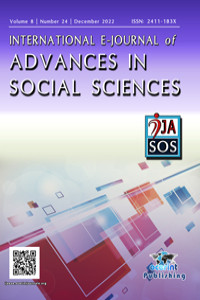THE SPREAD OF A CULTURE OF PEACE IS THE PATH TO PEACEKEEPING THROUGH LEGAL TEXTS: ENHANCING THE ROLE OF EDUCATION
Abstract
spreading a culture of peace in societies goes through the definition of peaceful means and methods for settling disputes. This can be done at the internal level by reforming the justice agencies and building citizens' confidence in them, and organizing and restoring traditional ways of resolving disputes and conflicts through reconciliation and dialogue and Education in order to spread a culture of peace and tolerance in contemporary societies which has become an urgent necessity. Today, education is required to aim at resisting the influence of factors that lead to fear and exclusion of others, and at helping young people to develop their capacities for independence of opinion and critical and moral thinking. Policies and programs should contribute educational curricula and other educational materials in promoting understanding, solidarity and tolerance among individuals and combating violence and extremism. The emergence of democratic culture at the global level is hoped to achieve this goal. In our opinion, the culture of peace is one of the pillars of the culture of democracy. Democratic behaviour is peaceful behaviour. It renounces violence whatever it is, except for legitimate self-defence, which is a natural right, and uses discussion, dialogue and persuasion as a means of dealing. Education aims to develop concepts of education for peace, a better human future, international cooperation and solidarity on the basis of justice, equality, interaction and mutual respect among all nations and peoples. UNESCO stresses that if the goal of education is to raise the level of educational attainment, the most important thing is to link education with life skills in order to prevent violence and build peace. The author addresses the situation at the level of national law, international law and other cultural data related to peace.
References
- 1. Article 1 of the Charter. (First paragraph)
- 2. Articles 6, 7 and 8 of the 1998 Rome Treaty, which includes the Statute of the International Criminal Court.
- 3. Article 10 of the League's bylaws.
- 4. Article 32 of the 1996 Constitution.
- 5. Article 33 of the Charter.
- 6. Article 34 of the same Constitution
- 7. Articles 39, 41 and 42 of the Charter.
- 8. Article 53 of the Convention on the Law of Treaties of 1969.
- 9. Bo sultan, Muhammad. - Maintaining peace and security in the world through legal texts. - Proceedings of the Forum for the New World Order and the Interests of Third World Countries, Blida University, 1993.- pp. 225-246.
- 10. Bo sultan, Muhammad. - Principles of Public International Law. - Part Two, Oran, Dar al-Gharb for Publishing and Distribution, 1999. - p.148.
- 11. GILL, T.D. - Limitations en U.N. Enforcement Powers. - Netherlands Y.I.L, 1995.- p.p. 99-198
- 12. HERMEL, Guy.- culture et démocratie. - UNESCO, 1993.-p.223.
- 13. WALDOCK, C.H.M.- The regulation of the use of force by Individual states in international law. - R.C.A.D.I, 1952.- p.470.
- 14. The human right to peace. - Statement by the Director-General of UNESCO, 1997.-pg.6.
- 15. From the speech of United Nations, the eighth Secretary-General Ban Ki-moon on the commemoration of the International Day of Peace on September 21, 2015
Abstract
References
- 1. Article 1 of the Charter. (First paragraph)
- 2. Articles 6, 7 and 8 of the 1998 Rome Treaty, which includes the Statute of the International Criminal Court.
- 3. Article 10 of the League's bylaws.
- 4. Article 32 of the 1996 Constitution.
- 5. Article 33 of the Charter.
- 6. Article 34 of the same Constitution
- 7. Articles 39, 41 and 42 of the Charter.
- 8. Article 53 of the Convention on the Law of Treaties of 1969.
- 9. Bo sultan, Muhammad. - Maintaining peace and security in the world through legal texts. - Proceedings of the Forum for the New World Order and the Interests of Third World Countries, Blida University, 1993.- pp. 225-246.
- 10. Bo sultan, Muhammad. - Principles of Public International Law. - Part Two, Oran, Dar al-Gharb for Publishing and Distribution, 1999. - p.148.
- 11. GILL, T.D. - Limitations en U.N. Enforcement Powers. - Netherlands Y.I.L, 1995.- p.p. 99-198
- 12. HERMEL, Guy.- culture et démocratie. - UNESCO, 1993.-p.223.
- 13. WALDOCK, C.H.M.- The regulation of the use of force by Individual states in international law. - R.C.A.D.I, 1952.- p.470.
- 14. The human right to peace. - Statement by the Director-General of UNESCO, 1997.-pg.6.
- 15. From the speech of United Nations, the eighth Secretary-General Ban Ki-moon on the commemoration of the International Day of Peace on September 21, 2015
Details
| Primary Language | English |
|---|---|
| Journal Section | Research Article |
| Authors | |
| Publication Date | January 7, 2023 |
| Submission Date | November 2, 2022 |
| Published in Issue | Year 2022 Volume: 8 Issue: 24 |
Contact: ijasosjournal@hotmail.com
The IJASOS Journal's site and its metadata are licensed under CC BY
Published and Sponsored by OCERINT International © 2015- 2025

